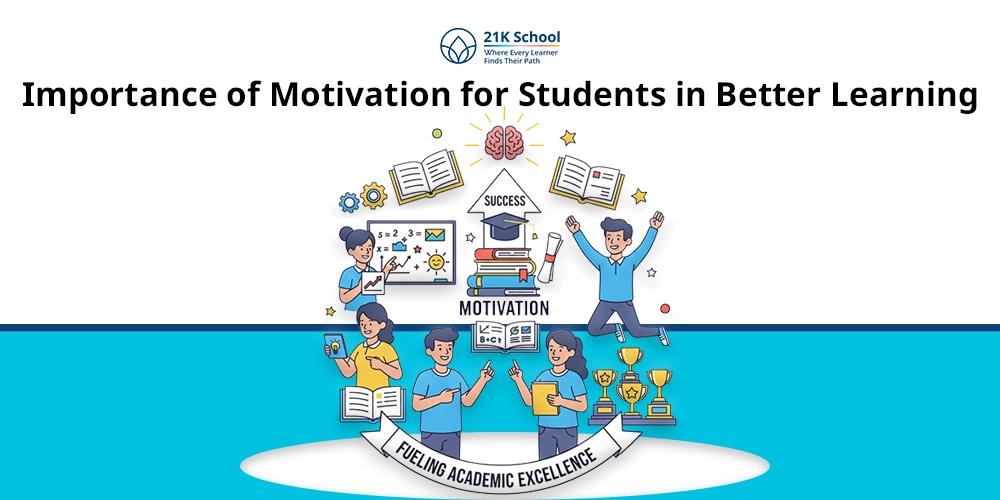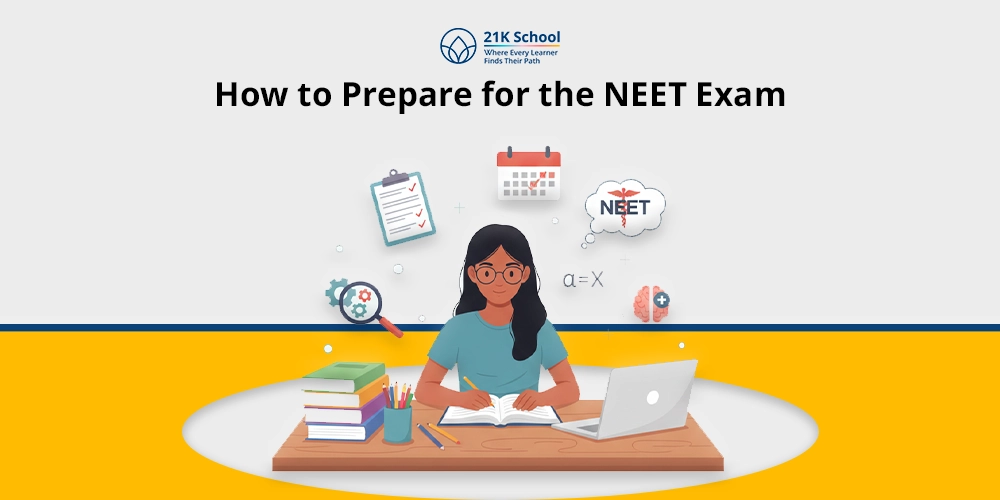
Students can learn without always relying on blackboards, texts and hours of instruction in one room. Depending on how kids are involved and how much they enjoy learning, education can be very effective.
Combining learning with activities that are fun, helps students keep important information and improve their daily life skills. Both parents and teachers who use enjoyable and involved ways of learning can make a big difference.
Noticing the boosting of how children perceive education. Such activities strengthen creativity, teamwork, problem-solving and curiosity which are important for students in the long run.
Here are 25 ideas to help learners of all ages enjoy while they learn.
Table of Contents
- 25 Fun Learning Activities For Kids
- 1. Art and Craft Activities
- 2. Backyard Treasure Hunt
- 3. Gardening
- 4. Try out Maths Games
- 5. Identify Colours
- 6. ABC Hopscotch
- 7. Dice Game
- 8. Board Race
- 9. Fraction War
- 10. Missing Cards
- 11. Phonics Play
- 12. Hangman
- 13. Scavenger Hunt
- 14. Pictionary
- 15. Charades
- 16. Story Cubes
- 17. Paper Airplane Competition
- 18. Memory Game
- 19. Karaoke at School
- 20. Painting Party
- 21. Sudoku Challenge
- 22. Dance Battle
- 23. Movie Day
- 24. Cooking Class
- 25. Crafting with Origami
- Give An Edge In Learning
25 Fun Learning Activities For Kids
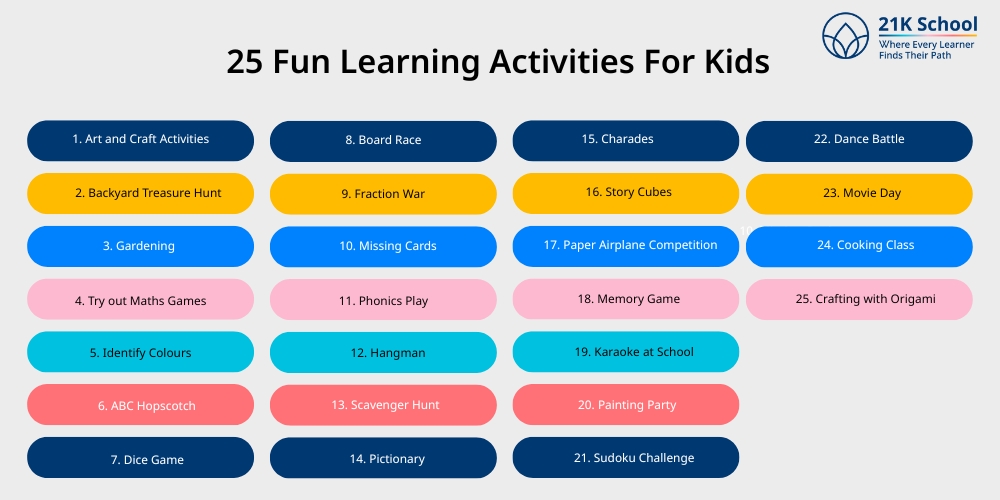
From ages, we were kept in a dilemma that learning has to be strict and bounded by rules. But, with developing angles on education, we have also learnt that learning can be fun as well.
The activities mentioned below are some of the best fun activities that support your kid’s learning and ensure developing curiosity.
1. Art and Craft Activities
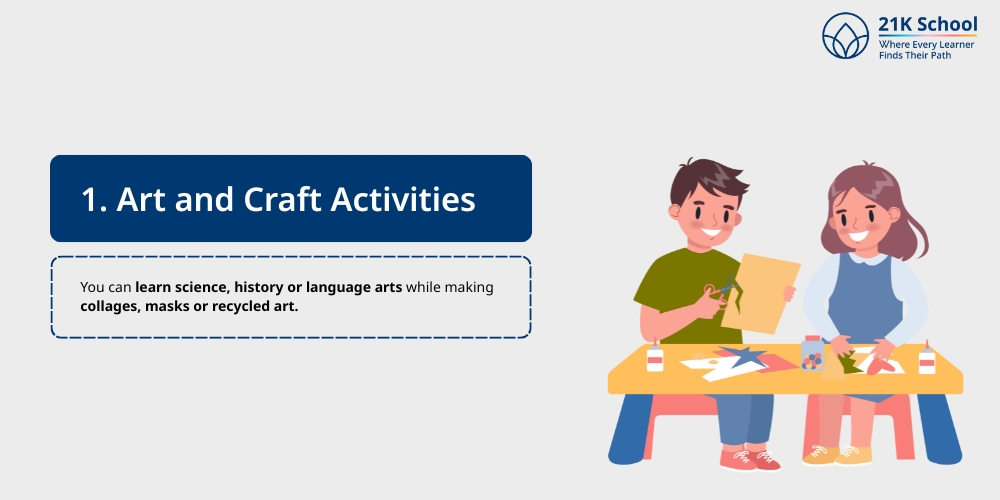
When people do crafts, they learn to be more creative and also patient, coordinated and good at following directions. You can learn science, history or language arts while making collages, masks or recycled art.
- Items needed: Paper, glue, scissors, markers and recycled items
- How to Do It: Organize them into groups and ask each group to carry out a themed task. Such as creating their own house or a collage of nature using arts and crafts.
- Key Tips: Try to include science (build a volcano) or history (make ancient artifacts) as part of your activities.
Also refer to these creative art and craft activities for kids.
2. Backyard Treasure Hunt
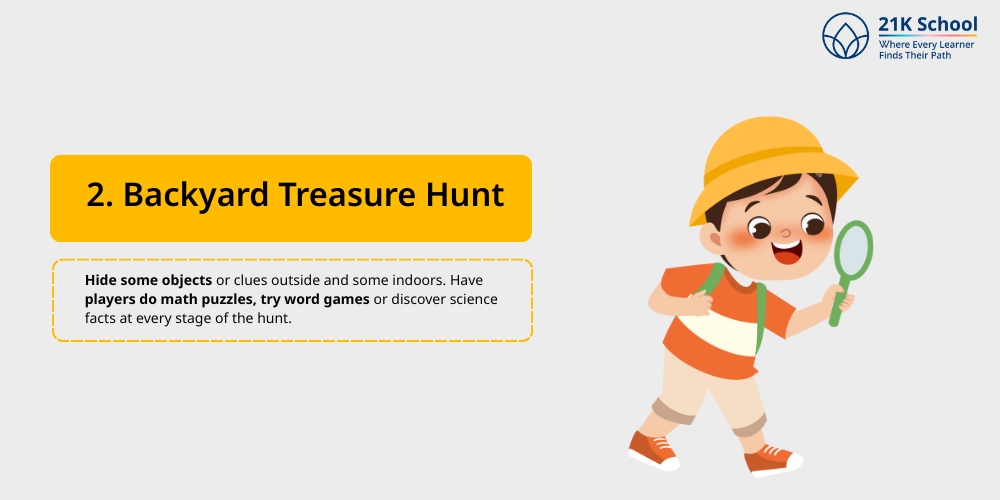
Hide some objects or clues outside and some indoors. Have players do math puzzles, try word games or discover science facts at every stage of the hunt.
It improves our critical analysis and attention to detect details.
- Materials Necessary: Printable clues, some small objects or tokens, baskets
- How to Do It: Secretly distribute clues all over a set spot. Every clue helps you move on and you receive a reward after finishing.
- Key Tips: Adjust the clues to match the learning goals (for example, asking math or geography-related riddles).
3. Gardening

Through gardening, students learn the stages of plant growth, how to be responsible and about the environment. Activities might include adding seeds to soil, composting or making plant journals to notice changes as they occur.
- Materials Required: You will need seeds, some soil, pots or a garden area and a watering can.
- How to Do It: Have the students plant the seeds and look after them, reporting what they notice along the way.
- Key Tips: You can teach kids about the life cycle of plants, looking after them and recording their progress.
4. Try out Maths Games
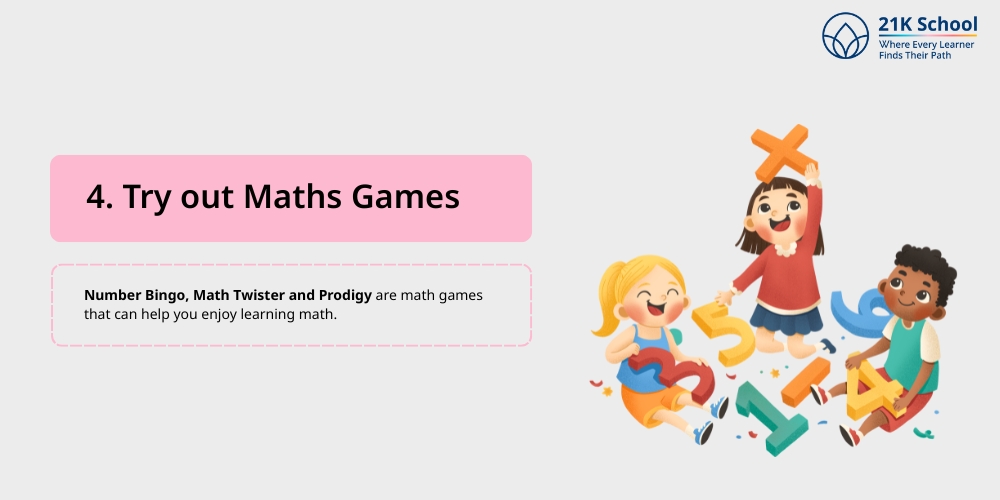
Number Bingo, Math Twister and Prodigy are math games that can help you enjoy learning math. These games strengthen the player’s understanding of basic things, fractions and how to solve problems.
- Materials Required: Dice, number cards, board games such as Math Bingo
- How to Do It: Play games where using math skills allows you to move forward or become the winner.
- Key Tips: Have different levels of difficulty so all students get involved in the game.
Here are some free best maths games for kids to improve skills.
5. Identify Colours

Handling toys, using flashcards or taking nature walks are good ways to teach kids about colors. Let children practice separating, organizing or identifying primary and secondary colors by painting and matching various objects.
- Materials Required: Flashcards, toys, fabric swatches, paints
- How to Do It: Make sure students are given objects to be sorted by color or are painting them in separate color groups.
- Key Tips: Try using the game “I Spy” with colors to make color recognition more fun.
6. ABC Hopscotch
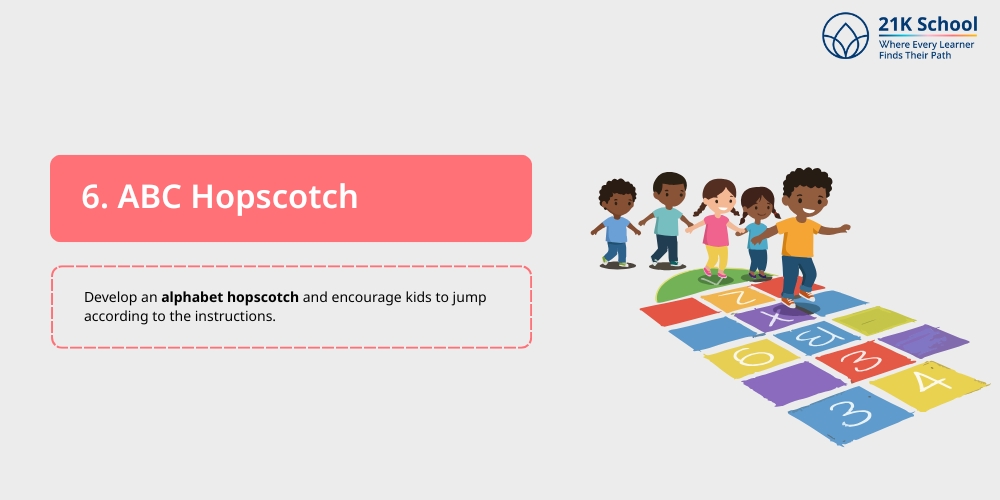
Develop an alphabet hopscotch and encourage kids to jump according to the instructions (e.g., first letter ‘c’ denotes “cat”). It improves reading and leads to more physical activity.
- Materials Required: Some chalk or masking tape and alphabet cards.
- How to Do It: Draw a hopscotch game in the form of the alphabet. Players shout or pronounce the letters as they leap from place to place.
- Key Tips: Include challenges like “name a word that starts with the letter you land on.”
7. Dice Game
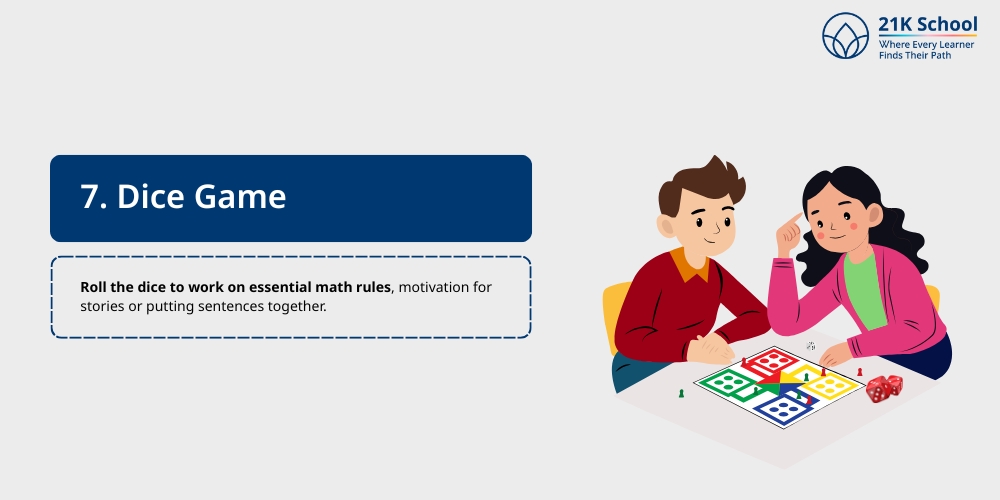
Roll the dice to work on essential math rules, motivation for stories or putting sentences together. To illustrate, one die is a verb and the other a noun, so students must build sentences with the words rolled.
- Materials Required: Dice and a list of tasks are the main materials.
- How to Do It: Each roll determines what educational activity people must do. For example: “roll a 4 and think of an animal word to spell”.
- Key Tips: Letting students create their own tasks will motivate them and show their creativity.
8. Board Race
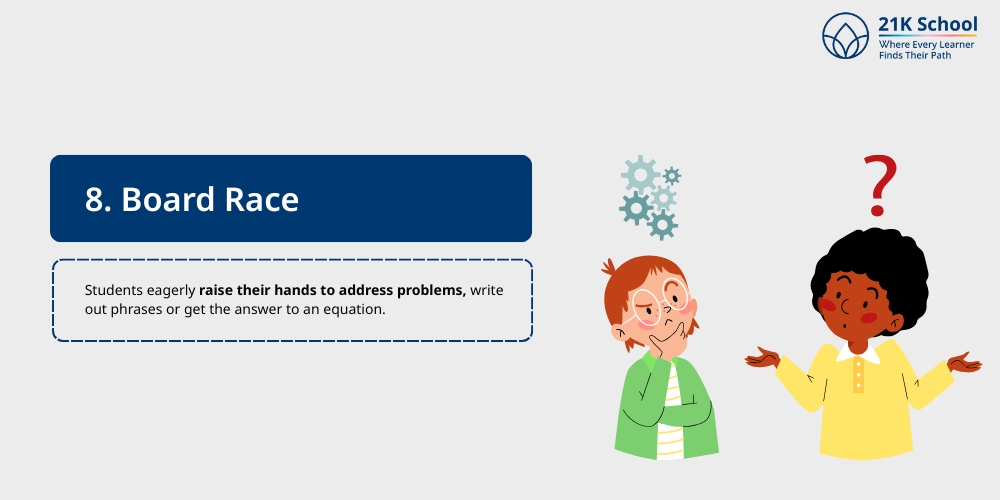
Group the students into groups of four or five. Students eagerly raise their hands to address problems, write out phrases or get the answer to an equation.
The pace is high and it encourages people to help each other and think fast.
- Materials Required: You will need a whiteboard, markers and a timer.
- How to Do It: Put students into groups. Students compete for the chance to go up and record the answers.
- Key Tips: Use a clock to make the rounds more exciting; switch the main subject every round.
9. Fraction War
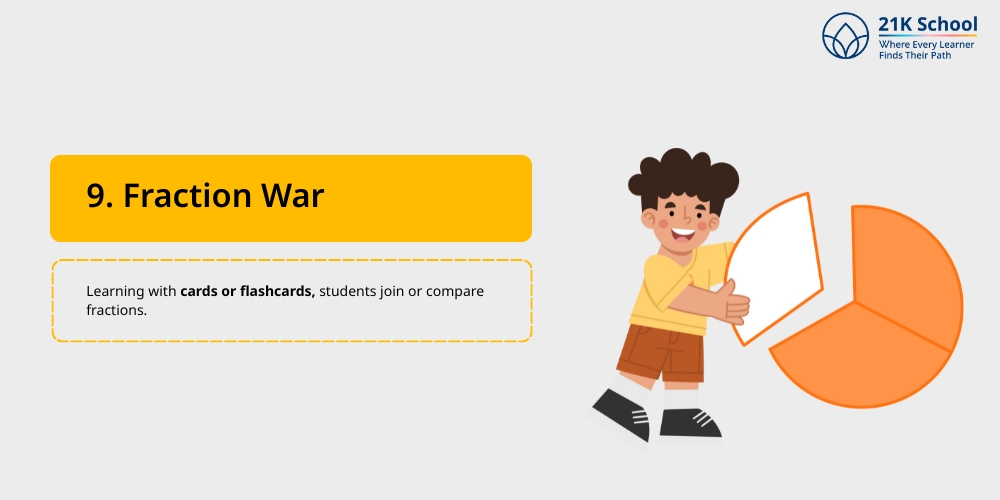
Learning with cards or flashcards, students join or compare fractions. The player with the bigger (or smaller) fraction is the winner.
It supports learning to see parts that make up a whole.
- Materials Required: You will need either a deck of playing cards or a set of fraction cards.
- How to Do It: Each person takes two cards to form a fraction and the highest wins that round.
- Key Tips: For younger students, try giving out visual fraction strips as an example.
10. Missing Cards
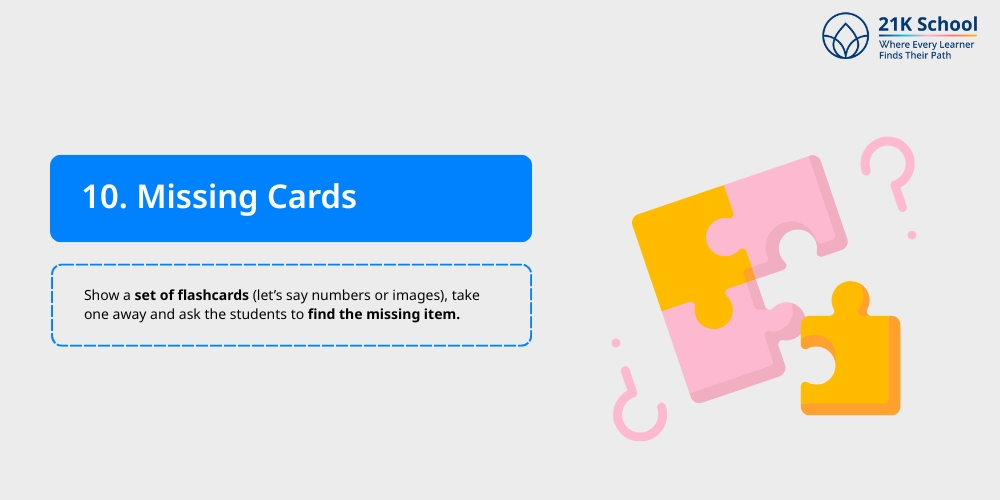
Show a set of flashcards (let’s say numbers or images), take one away and ask the students to find the missing item. Doing these things helps us remember and identify patterns more easily.
- Materials Required: Numbers, letters and words on flashcards
- How to Do It: Show all the cards at once and then take out one. Students try to guess which card is not in the set.
- Key Tips: Start with only a few cards and then raise the difficulty as you go on.
11. Phonics Play
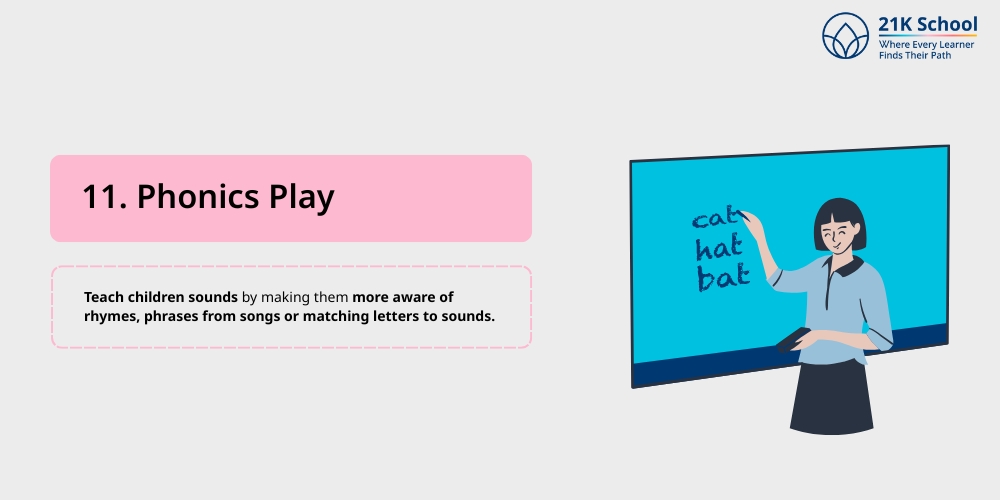
Using interactive phonics activities helps children develop reading abilities. Teach children sounds by making them more aware of rhymes, phrases from songs or matching letters to sounds.
- Materials Required: You will need magnetic letters, a set of rhyming cards and some phonics apps.
- How to Do It: Mix the sounds of letters, find letters or words that rhyme. Or put words into groups based on the sounds they make.
- Key Tips: If someone learns best through sound, use songs or chants to help reinforce the information.
12. Hangman
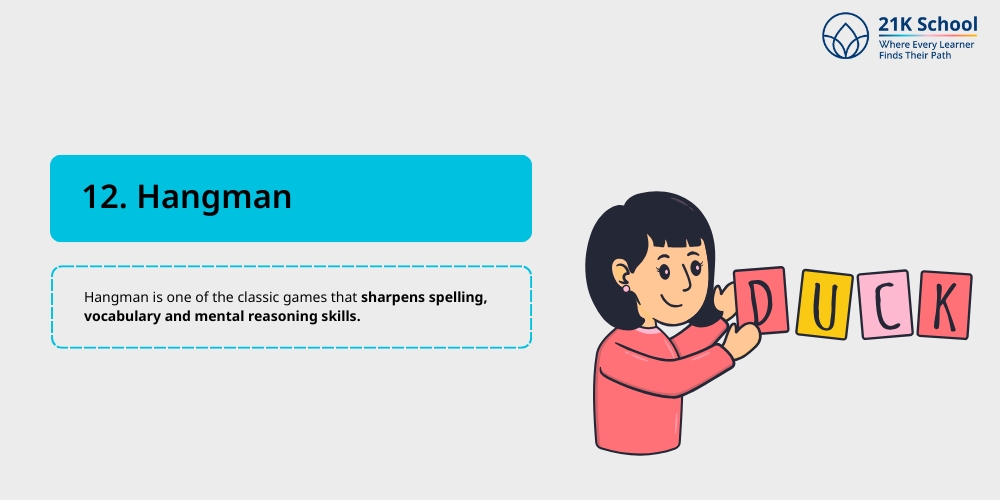
Hangman is one of the classic games that sharpens spelling, vocabulary and mental reasoning skills. Select a topic such as science terminology or important historical people, for the words to be arranged around.
- Materials Required: A whiteboard or some paper and a list with the words.
- How to Do It: A student who is thinking of a word lets everyone guess letters. And the guesses go on until everyone knows the word or the word is crossed off in the drawing.
- Key Tips: Try to use important terms from recent lessons as you go along.
13. Scavenger Hunt
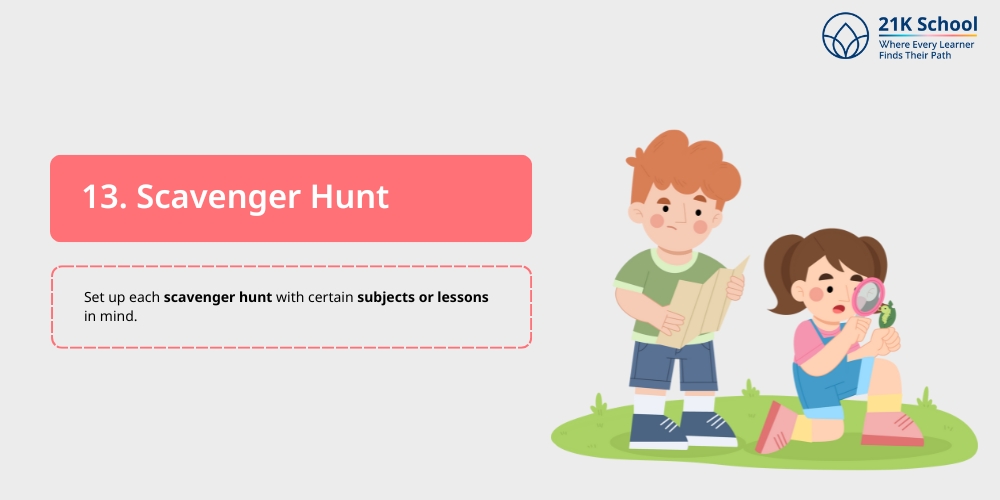
Set up each scavenger hunt with certain subjects or lessons in mind. Ask yourself if the objects are magnetic, symmetrical, living or have a connection to something in your textbook.
- Materials Required: Checklists, clipboards and pencils are needed for this task.
- How to Do It: Hide different articles in different places. Give students a list of objects to look for in the environment (e.g., a circle, an adjective, a living being).
- Key Tips: Put students in groups and pay attention that every student is involved.
14. Pictionary
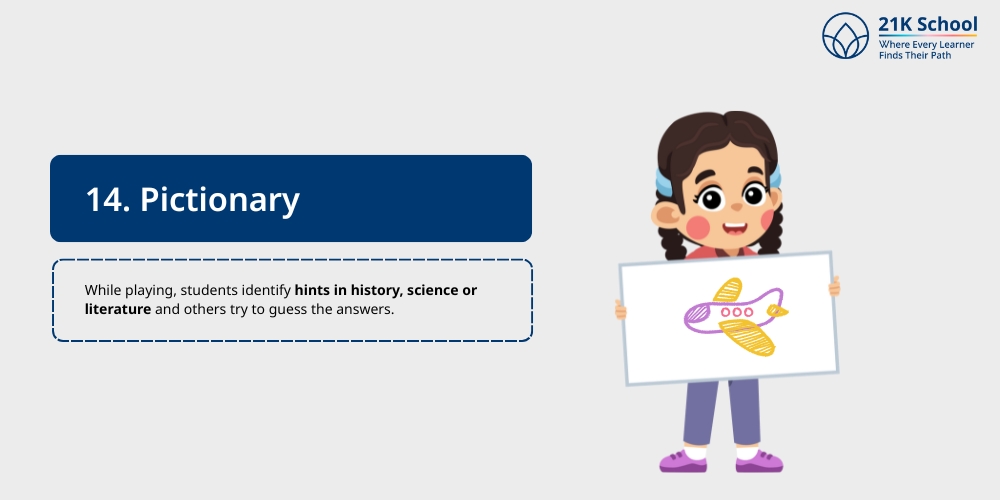
While playing, students identify hints in history, science or literature and others try to guess the answers. It supports seeing and remembering new ideas.
- Materials Required: You will need a whiteboard or some paper, a timer and a word list.
- How to Do It: One student draws and the rest try to guess what the picture represents.
- Key Tips: Keep the activities educational by using terms from science and characters from books.
15. Charades
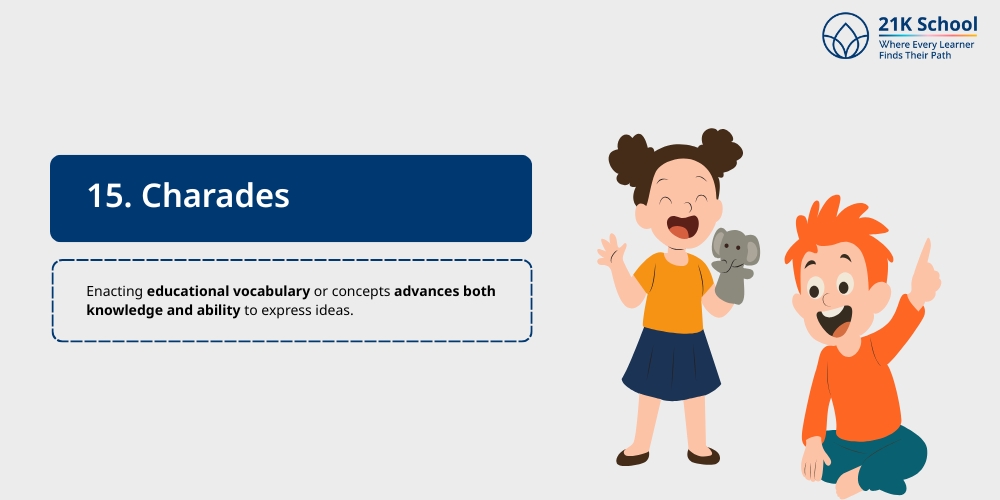
Enacting educational vocabulary or concepts advances both knowledge and ability to express ideas. It becomes very useful for people learning languages or for children who are building their communication skills.
- Materials Required: Word cards, timer
- How to Do It: Students behave as an object or idea silently; other students guess what they are acting.
- Key Tips: Focus on gestures and hold off guessing until the total performance is done.
16. Story Cubes

Let the stories come to life by having students make a story from what they roll on dice with pictures or prompts. This forms how you tell a story, the words you use and your creative thinking skills.
- Materials Required: Obtain dice with pictures on them for this game (alternatively, you could draw your own).
- How to Do It: Handle the cubes and use the images displayed to form a story.
- Key Tips: Give students chances to work together in teams so they can learn to cooperate.
17. Paper Airplane Competition
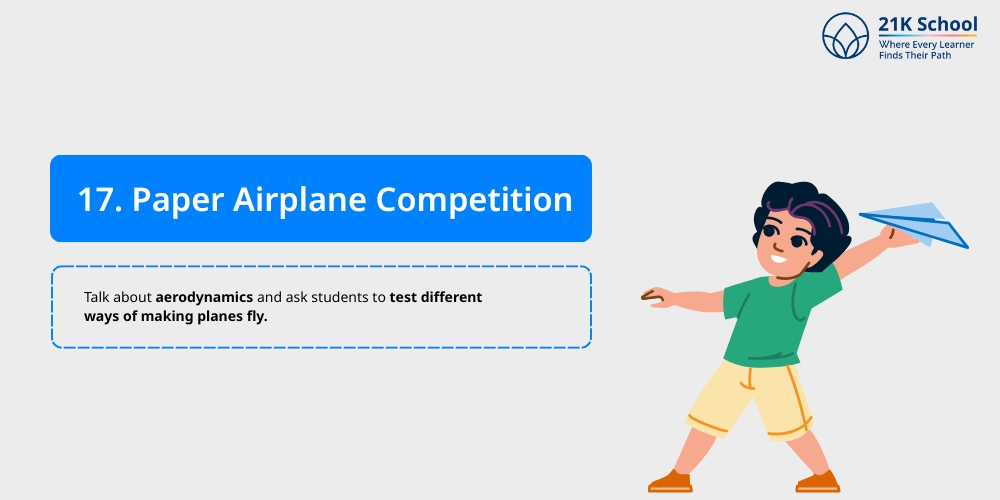
Talk about aerodynamics and ask students to test different ways of making planes fly. Determine the lengths of flights, gather data and see what makes some planes fly farther.
- Materials Required: You need paper and a measuring tape for the exercise.
- How to Do It: Students first build their planes, send them into the air and note the distances they travel. Discuss aerodynamics.
- Key Tips: Suggest that they experiment with varying the fold and the weight of the paper.
18. Memory Game

Link imagery to vocabulary terms, numbers to equations or matching cards with their equivalent terms. It increases recall of recent memories and the linking of new ideas.
- Materials Required: These activities need sets of cards with identical images or the same concept.
- How to Do It: Lay all the cards on the table with their faces down. Students alternate in flipping the cards to match them.
- Key Tips: Make decks of cards focused on specific topics (mathematics and vocab) to help your learning.
Read on to learn more about memory games for kids.
19. Karaoke at School
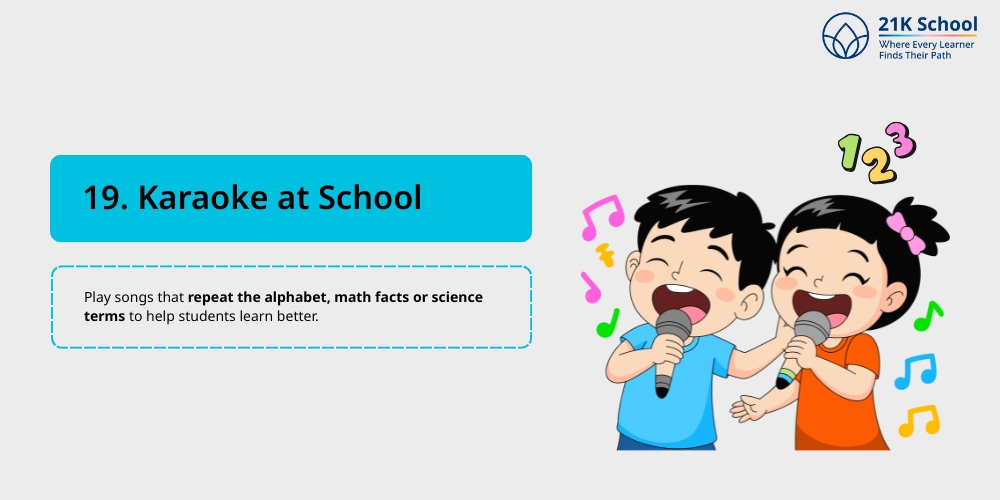
Play songs that repeat the alphabet, math facts or science terms to help students learn better. Using karaoke helps people feel more confident and entertained as they improve their language skills.
- Materials Required: To perform this, you (or the students) need lyrics sheets, speakers and a microphone (if wanted).
- How to Do It: Teach students by playing songs in the classroom, whether in groups or alone.
- Key Tips: Have students pick what they would like to learn to improve their participation.
20. Painting Party
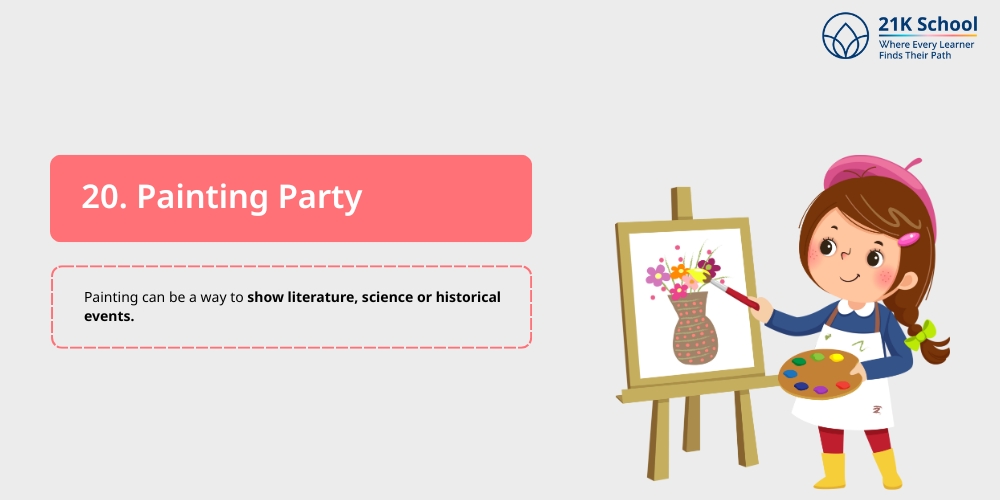
Painting can be a way to show literature, science or historical events. Students can share their learning creativity, reaching visual and kinesthetic learning styles together.
- Materials Required: Paints, brushes and either paper or canvas
- How to Do It: Students use paint to re-create a subject or idea from their lesson. For example: the water cycle or the settings from books.
- Key Tips: Put the artwork on display, forming a classroom gallery and this will help students grow in confidence.
Here’s how to build confidence in children.
21. Sudoku Challenge
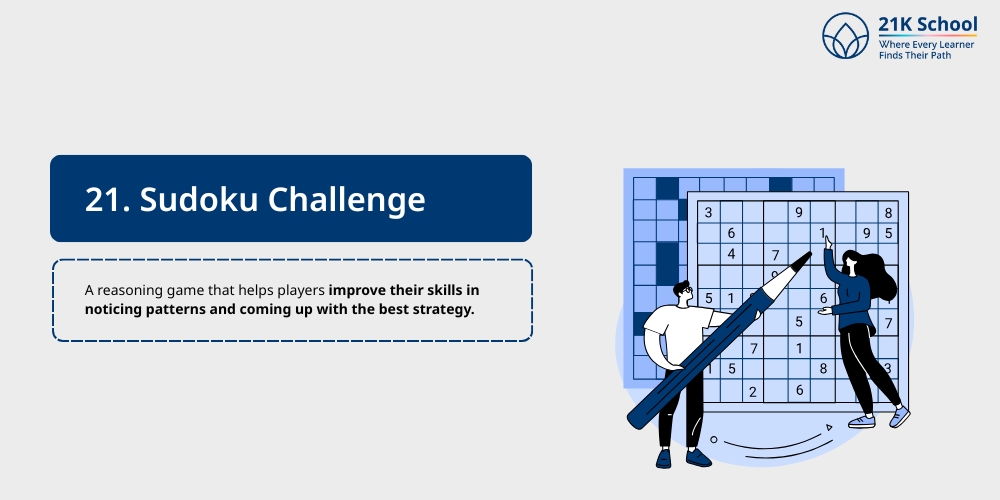
A reasoning game that helps players improve their skills in noticing patterns and coming up with the best strategy. Focus on the basics by testing out 4×4 grids and then make them more complicated.
- Materials Required: Some Sudoku puzzles (on paper or through the internet).
- How to Do It: Give students puzzles that match their age. Check how quickly or how correctly someone completes the task.
- Key Tips: Beginners should use 4×4 grids and you can also help them notice patterns.
22. Dance Battle
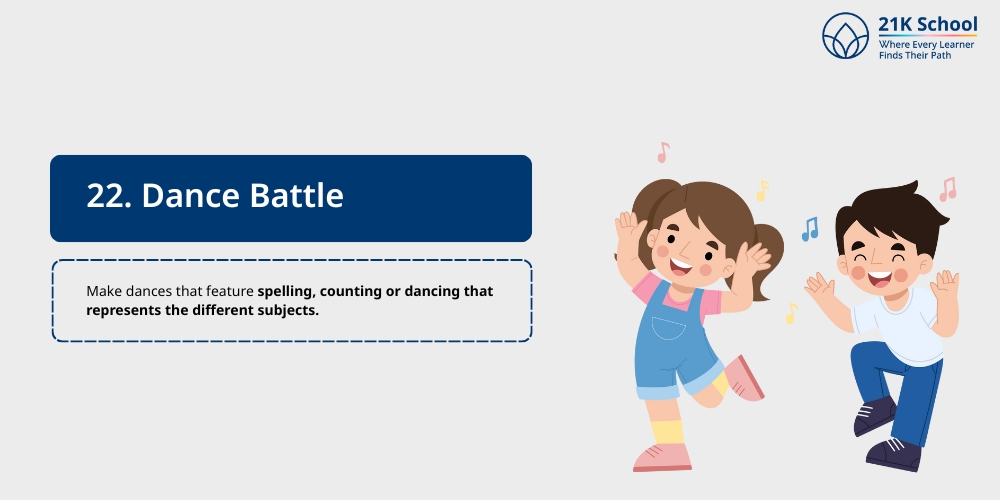
Make dances that feature spelling, counting or dancing that represents the different subjects. It favors learning through movement, increases coordination and builds confidence.
- Materials Required: A place where you can move and music to listen
- How to Do It: Host a dance-off by using songs that help with classroom learning (e.g., the ABC song).
- Key Tips: Praise creativity and enthusiasm as much as you praise the technical skills of your students.
23. Movie Day
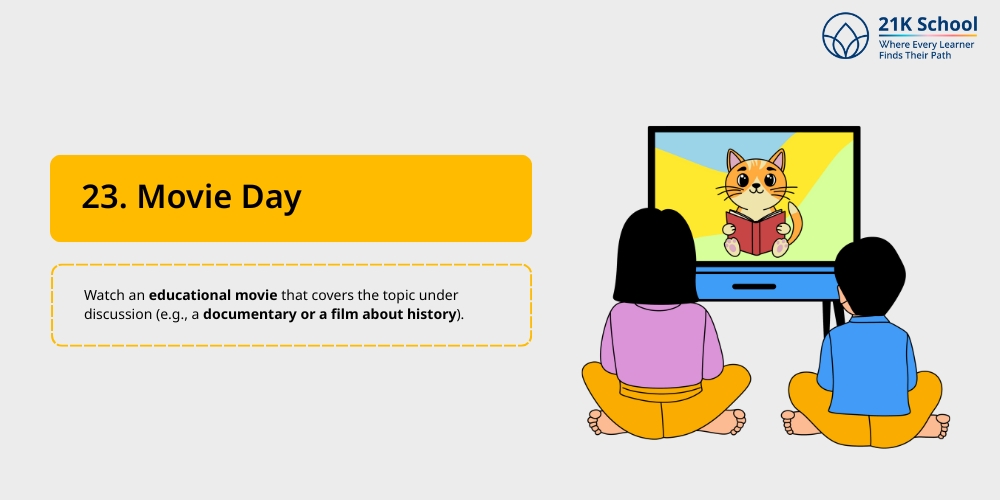
Watch an educational movie that covers the topic under discussion (e.g., a documentary or a film about history). After, bring the group together for a group discussion, quiz or reflection worksheet.
- Materials Required: You will need a movie for students, projector and worksheets as materials.
- How to Do It: Watch a film that supports your academic topic. Ask students to talk about or clarify what they have learned.
- Key Tips: Pause the lesson occasionally to allow students to ask questions.
24. Cooking Class
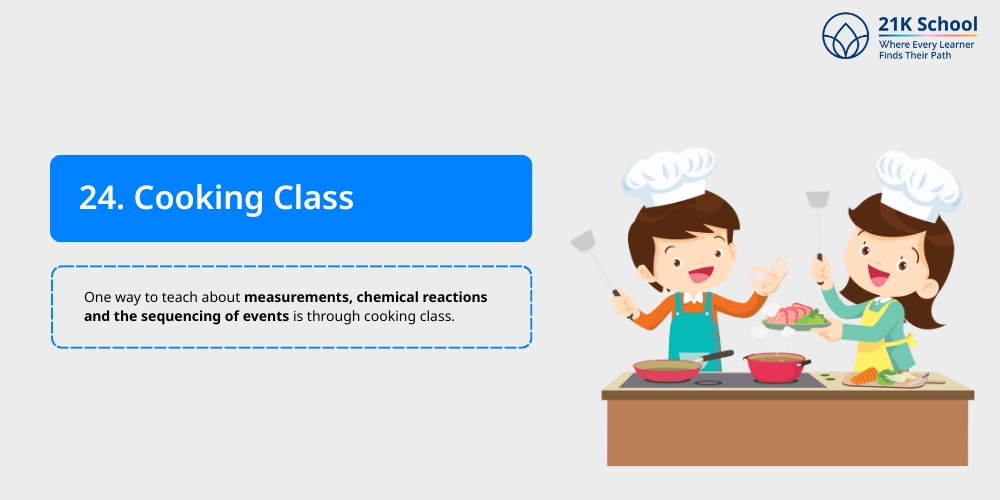
One way to teach about measurements, chemical reactions and the sequencing of events is through cooking class. Making recipes teaches children about math, science and following orders.
- Materials Required: The ingredients for food, tools for measuring and recipe printouts
- How to Do It: They can make basic and safe recipes at the same time as studying measures, order and chemical changes.
- Key Tips: Cook dishes from around the world to combine social studies and diversity.
25. Crafting with Origami

Doing origami helps improve a person’s understanding of geometry and their spatial perception. Children handle paper instructions and learn about symmetry, angles and problem-solving with their hands.
- Materials Required: Origami paper and instruction information from the sheets or videos
- How to Do It: Perform activity by folding paper into animals, shapes or objects as you discuss different geometry topics.
- Key Tips: Show students how to do the task step by step and slowly.
Give An Edge In Learning
Fun activities in school help children view learning as an exciting task they like, instead of something they must do.
They help develop curiosity, creativity and the ability to cooperate which are vital for doing well in school and life.
When lessons are exciting and interactive, students grasp more, improve their social and emotional skills and continue loving learning.
Even using simple classroom games or doing hands-on activities, fun styles of teaching are just as powerful as standard lessons.
When there is a mix of structure, imagination and joy, education becomes more powerful.

